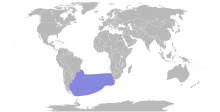The Atlantic petrel (Pterodroma incerta) is a gadfly petrel endemic to the South Atlantic Ocean. It breeds in enormous colonies on Tristan da Cunha and Gough Island, and ranges at sea from Brazil to Namibia, with most records at sea being to the west of the breeding islands, and along the subtropical convergence.[2] Adults are about 43 cm long, powerful, large, stocky, dark in color with white belly.[3] Their head can appear to be grey in worn plumage. Brown undercoating of wings and tail. These petrels can live on average of 15 years of age.[3]
| Atlantic petrel | |
|---|---|

| |
| Scientific classification | |
| Domain: | Eukaryota |
| Kingdom: | Animalia |
| Phylum: | Chordata |
| Class: | Aves |
| Order: | Procellariiformes |
| Family: | Procellariidae |
| Genus: | Pterodroma |
| Species: | P. incerta
|
| Binomial name | |
| Pterodroma incerta (Schlegel, 1863)
| |

| |
Population trends
editAlthough the species exists in large numbers, the world population being estimated at around 5 million birds, it is listed as endangered by the IUCN. It is restricted to just two breeding islands and has declined historically due to exploitation for food. According to some studies, there are roughly 1.1 million mating pairs, but only about 25% of eggs survived.[4] This is making their large population numbers decrease rapidly. Gough Island was the location of study, since other islands are inaccessible due to the steep cliffs.[5] Due to reproduction mortality, this species can become locally extinct making their home range smaller.
Habitat and ecology
editThe species feeds mostly on squid, which comprise 87% of its diet in some studies; it will also feed on lanternfishes (Myctophidae) as they ascend to the surface at night, as well as on crustaceans and some fish.[2] This species is known for its nocturnal breeding habits.[4] The nesting locations are between 50 and 300 meters above sea level, located on cliffsides on Gough Island and formerly, at Tristan da Cunha it was upwards of 700 meters.[6] It nests in burrows dug in peaty soils in fern-bush vegetation.
Predators and threats
editThe Atlantic petrel is currently threatened by introduced house mice, which prey on recently-hatched chicks.[4] Mouse predation is particularly prevalent on Gough Island, whose mice have rapidly evolved to be about twice the size of their mainland counterparts through a phenomenon commonly known as island syndrome.[7]
Given their small breeding range, severe hurricanes also pose an intermittent threat to breeding populations.[8] Increasingly severe storms also threaten the availability and predictability of food sources such as squid.[3]
Conservation efforts
editStarting around the 1970s, on Tristan da Cunha, they have programs to teach and learn about this species and why it is important for the ecosystem.[3] They also educate about the dangers that the birds are facing and research ways to implement protection for them in the future. Considering their populations numbers are high, their declining population is thought to be due to the mortality rate of eggs and young. Gough Island is a nature reserve and World Heritage site, there is a field station on this island to observe the Atlantic Petrels population.[6] Research on the House mouse is important to finding ways in reducing these predators' effect on the Atlantic Petrels.[3]
Proposed actions
editFurther studies on the house mouse have focused on ways to eradicate mice on Gough Island, minimizing the risk of introducing other invasive species, and finding methods better to understand the Atlantic petrel's habits.[4] Demographic mapping is being used to better understand the island and its animal population trends.
The petrel was formerly classified as a vulnerable species by the IUCN.[9] However, new research revealed the severe impact of predation by mice, and the species was uplisted to endangered in 2008.[10]
Footnotes
edit- ^ BirdLife International (2019). "Pterodroma incerta". IUCN Red List of Threatened Species. 2019: e.T22698084A152715347. doi:10.2305/IUCN.UK.2019-3.RLTS.T22698084A152715347.en. Retrieved 11 November 2021.
- ^ a b Klages, N.T.W.; Cooper, J. (1997). "Diet of the Atlantic petrel Pterodroma Incerta during breeding at South Atlantic Gough Island" (PDF). Marine Ornithology. Retrieved 2016-04-01.
- ^ a b c d e IUCN (2019-06-14). "Pterodroma incerta: BirdLife International: The IUCN Red List of Threatened Species 2019: e.T22698084A152715347". BirdLife International. doi:10.2305/iucn.uk.2019-3.rlts.t22698084a152715347.en.
- ^ a b c d Cuthbert, Richard; Hilton, Geoff (2004-06-01). "Introduced house mice Mus musculus: a significant predator of threatened and endemic birds on Gough Island, South Atlantic Ocean?". Biological Conservation. 117 (5): 483–489. Bibcode:2004BCons.117..483C. doi:10.1016/j.biocon.2003.08.007. ISSN 0006-3207.
- ^ Dilley, Ben J.; Davies, Delia; Bond, Alexander L.; Ryan, Peter G. (2015-06-30). "Effects of mouse predation on burrowing petrel chicks at Gough Island". Antarctic Science. 27 (6): 543–553. Bibcode:2015AntSc..27..543D. doi:10.1017/s0954102015000279. ISSN 0954-1020. S2CID 86782992.
- ^ a b "Cooper, J. & Ryan, P.G.Management plan for the Gough Island Wildlife Reserve. Government of Tristan da Cuhna. (1994). 96pages. No price indicated. ISBN 09 03359 38 3". Antarctic Science. 6 (4): 544. December 1994. Bibcode:1994AntSc...6Q.544.. doi:10.1017/s0954102094260807. ISSN 0954-1020. S2CID 246043428.
- ^ Stratton, Jered A (April 2021). "Evolution of boldness and exploratory behavior in giant mice from Gough Island". Behavioral Ecology and Sociobiology. 75 (4). etal. Heidelberg: 65–77. doi:10.1007/s00265-021-03003-6. ISSN 0340-5443. PMC 8716023. PMID 34970019. ProQuest 2501368931.
- ^ Bugoni, Leandro; Sander, Martin; Costa, Erli Schneider (December 2007). "Effects of the First Southern Atlantic Hurricane on Atlantic Petrels (Pterodroma Incerta)". The Wilson Journal of Ornithology. 119 (4): 725–729. doi:10.1676/06-141.1. ISSN 1559-4491. S2CID 85595992.
- ^ BLI (2007)
- ^ BLI (2008a,b)
References
edit- BirdLife International (BLI) (2008a): 2008 IUCN Redlist status changes. Retrieved 2008-MAY-23.
- BirdLife International (BLI) (2008b): Atlantic Petrel Species Factsheet. Retrieved 2008-MAY-23.
- Enticott, J.W. (1991): Distribution of the Atlantic Petrel Pterodroma incerta at sea. Marine Ornithology 19(1): 49–60. PDF fulltext
- Klages, N.T.W. & Cooper, J. (1997) Diet of the Atlantic Petrel Pterodroma incerta during breeding season at South Atlantic Gough Island. Marine Ornithology 25(1+2): 13–16. PDF fulltext
